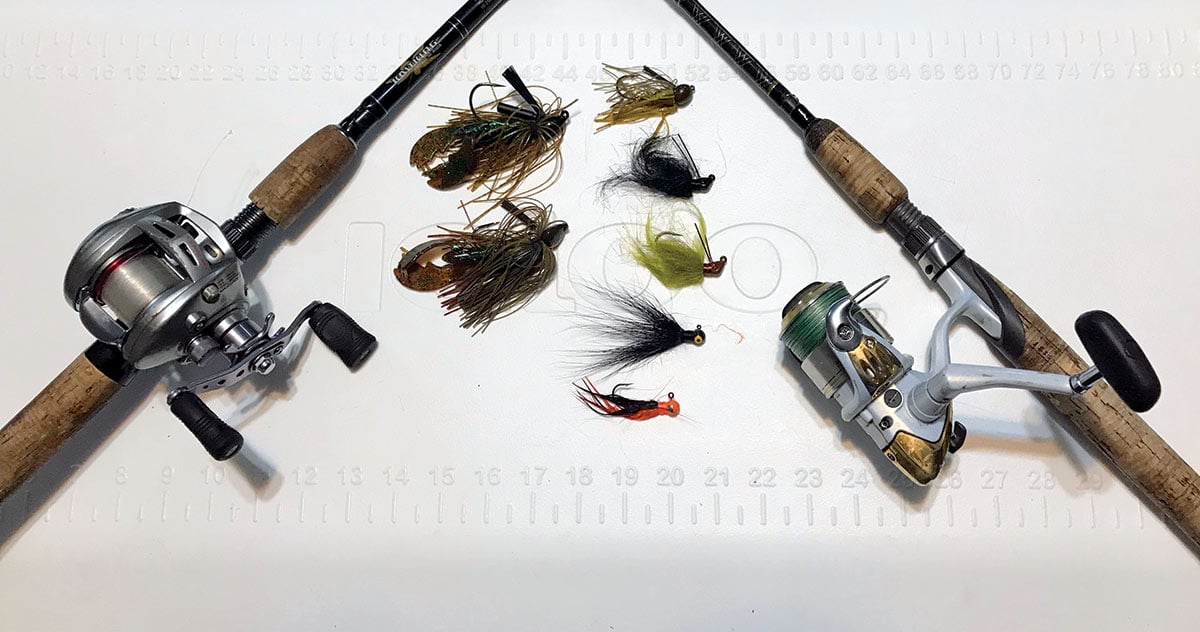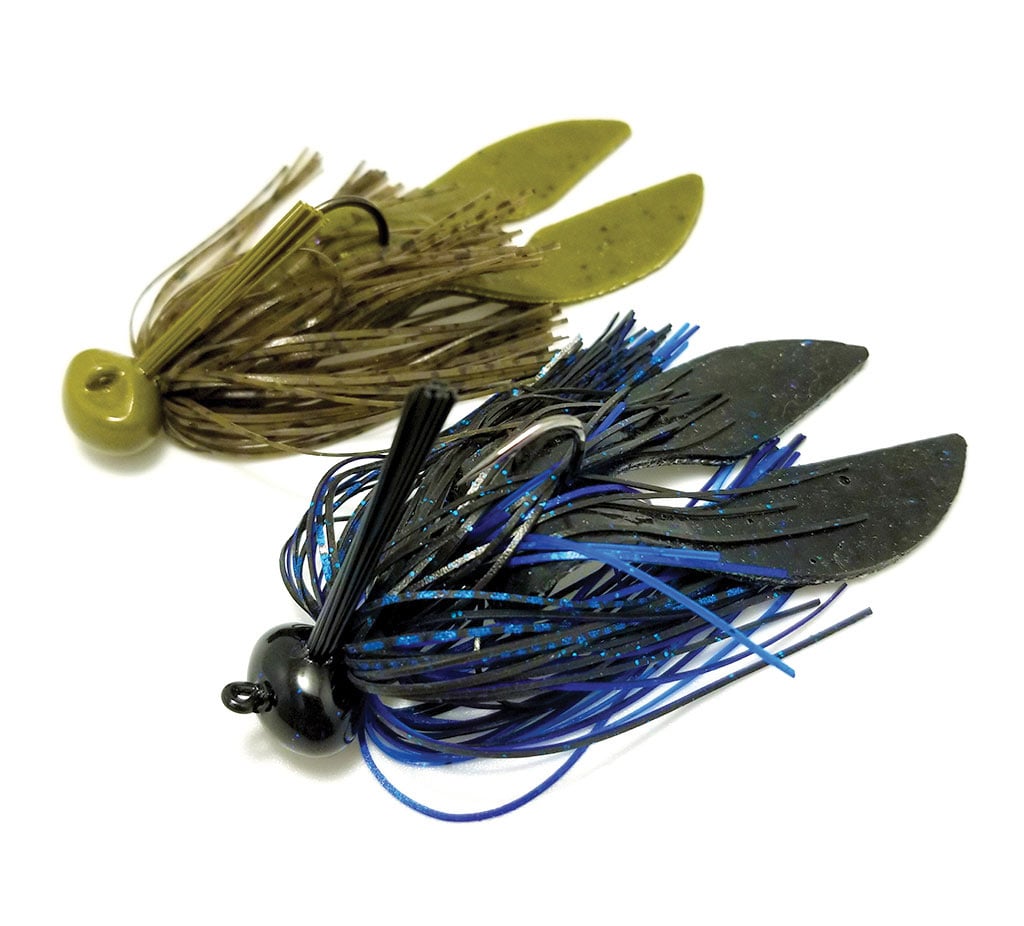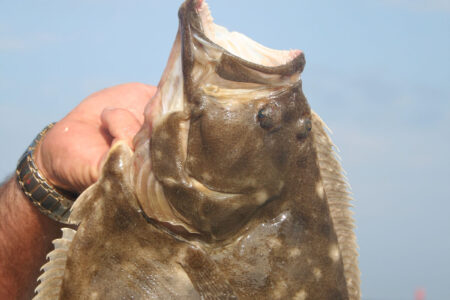
Become proficient at fishing jigs and you can pull bass from the Island’s kettle hole lakes all season long.
I have been fishing kettle hole lakes for largemouths my entire life here on Long Island. They are normally full of life, deeper than most ponds and have an ample supply of quality bass in them. Before we get into the ins and outs of kettle hole bassin’ let’s explore what exactly kettle hole lakes are, and why theyare, in my opinion, so attractive to bass and other species of fish on Long Island.
A kettle hole is basically a somewhat round lake that was formed as glaciers melted and then were filled by rain water or underground springs. They began as a large piece of ice that broke away from the edge of a retreating glacier. This large chunk of ice was covered with sediment,became partially buried and after the ice melted, it left a hole. The reason these lakes are usually round is ice melts evenly and usually in a spherical shape. However, distorted or branching depressions can result from irregular ice masses. Kettle holes on Long Island can be deep, as evidenced by our largest, Lake Ronkonkoma, with depths in excess of 65 feet. Kettle hole lakes can be as small as 15 feet and up to eight miles in diameter. Although this article is about Long Island’s kettle holes, these types of lakes are common in Wisconsin, Minnesota and New England as well.
Pick One
Long Island features eight kettle hole lakes. The largest and most well-known is Lake Ronkonkoma. Others on Long Island include Laurel Lake, Artist Lake, Lake Panomoka, Lake Success, Deep Pond and Oakland Lake. Depending on where you fish, any of these sevenhas the potential to produce some excellent bassin’. Some like Lake Success are private, and you will need to gain access through a friendly homeowner or another means of creative access such as stashing a rod in your golf bag.

As I mentioned, these lakes can be deep, and in Long Island’s case, most are considerably deeper than other lakes. Artist Lake for instance, although currently shallower than normal, had depths of up to 8 feet. Lake Ronkonkoma is the deepest at over 65 feet, while Panomoka and Success boast depths up to and exceeding 20 feet. Laurel Lake has depths measuring 10-plus feet. While they may seem shallow compared to many other lakes throughout the Northeast, that is not the case on Long Island where most lakes and ponds average 3 to 7 feet in depth.
Depth is not the only reason these bodies of water produce good fishing. Most are fed by some form of spring, which keeps the water a little cooler than most, and in turn does not allow the lake to get choked off by weeds, such as Lower Lake in Yaphank, which has turned into a cabbage patch with only 3 feet of water due to muck and weed growth.
Jig ‘em up
I love to fish jigs for largemouths. A jig to me imitates so many of the food sources bass love, and they can be fished in many ways. When it comes to kettle hole lakes, nothing in my mind beats a jig, and they are effective all season long, including through the ice. I use a variety of jigs weighing anywhere from 1/8 ounce up to 1 ounce, depending on cover, method and time of year. In winter and early spring, when waters are cooler, smaller 1/8-ounce hair jigs in black or olive get the nod. In the case of hair jigs, I prefer to fish them nakedand never add a trailer. A small jig head from 1/8 to 1/4 ounce with a curly tail grub is also effective during the cooler months. When it comes to fishing the hair jig or small jig head and grub, simply cast out and slowly reel towards the shore or boat, allowing it to settle from time to time during the retrieve. A bass usually hits the jig on the fall, or as it is slowly rooting along the bottom.

As the waters begin to warm up, a beefier jig and a Big Bite Baits Fightin Frog or Strike King Rage Craw as a trailer can’t be beat. The time of year and which body of water you are fishing dictate which technique is most effective. In Lake Ronkonkoma and Lake Panamoka, I like a 1-ounce jig, which allows for long casts. After casting, I allow the jig to settle to the bottom, and slowly hop or drag it back towards the shore or boat. This imitates a baitfish rooting along the bottom or crayfish, which are present on Long Island, although not in the numbers found in other parts of the country.
My other choice is the KVD Strike King swim jig. The best part about a swim jig is it can be fished in any situation – around cover, open water, bushes, down rocky banks and in lily pad fields. A swim jig has a good profile and mimics natural forage species, especially smaller fry and bluegills. With that being said, bluegill colors are best here on Long Island. A swim jig is exactly what it is called. To fish them, make long casts over any fishable area and begin a slow, but steady retrieve. I also like to pause and change up the retrieve if the fish are not overly active. And, if the opportunity arises, bang that jig off any structure you see or feel.
A Good Jig Outfit
No article would be complete without giving a few tips regarding rods and reels. When fishing jigs, anything under 3/8 ounce is best suited for lighter spinning gear, and that usually means lighter lines. On a hair jig I use a 6-foot, 6-inch to 7-foot rod with a Shimano Stradic 2500 series reel. My line of choice is Kast King’s Fortis braid with a trace of 6-pound fluorocarbon. I have also changed over to brighter colored yellow braid for visibility purposes. The fluoro is tied to the braid using a double uni-knot and then held tight with a shot of Berkley line glue.

As the jigs get larger, I prefer conventional baitcasters. I feel the larger jigs are easier to control with a baitcasting outfit. For most instances I like Bass Pro Shops XPS fluorocarbon line in 10- to 20-pound test, depending on cover and structure. For Lake Ronkonkoma, 10-pound test is fine as snags are not that prevalent. In Artist Lake where there is substantial cover and structure, I favor bumping up to 20-pound test. Unlike crankbaits and topwaters, I do not feel the line rating alters the jig’s ability to catch with the heavier jigs. The smaller hair jigs, sincethey are so much lighter, need the lighter line to make for a more natural presentation.
I named seven kettle hole lakes here on Long Island. The eighth remains a secret for you to find on your own. I have fished all of these except for Oakland, and all of them have produced largemouths and smallies up to 6 pounds. Once you master fishing jigs and put them in play on some of these kettle hole lakes, it will add a whole new dimension to your freshwater fishing here on Long Island.
| NEW CRAW TRAILER FROM FAT COW |
|---|
| The latest trailers to dress up your flipping jigs comes from Long Island based Fat Cow. Just introduced following extensive field testing are their garlic scented 3-inch Craw Trailer that is available in White Pearl, Blue Black Fleck, Green Pumpkin and Green Watermelon. They have also introduced a fish scented 3-1/2-inch Eel Tail in chartreuse, ghost white, hot bubblegum and blood red that can be used on swim jigs and frog baits. Scents are made from real bait and packed with amino acids, and stimulants (pheromones). These trailers are 40X stronger than soft plastic baits, will never dry out or shrivel, and can be left on the hook and re-used over and over. Check them out at www.fatcowfishing.com.
|





